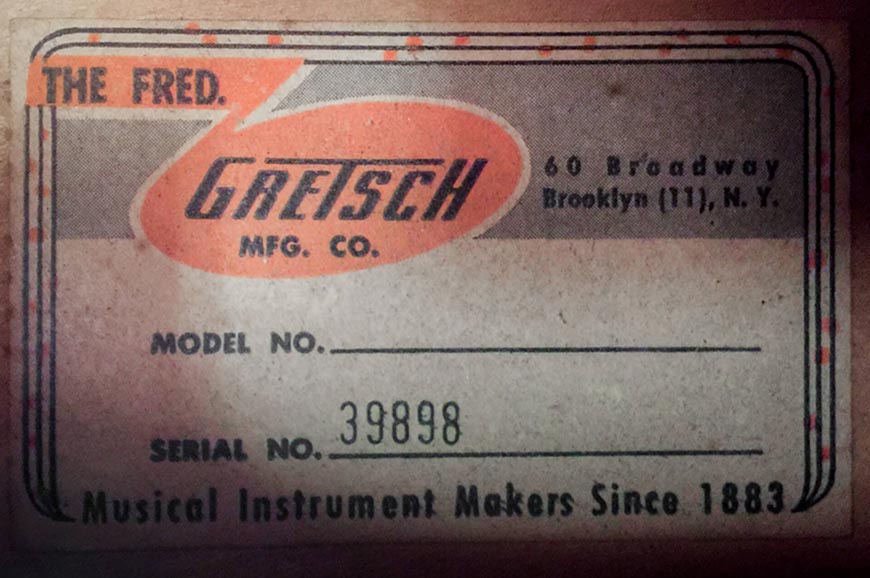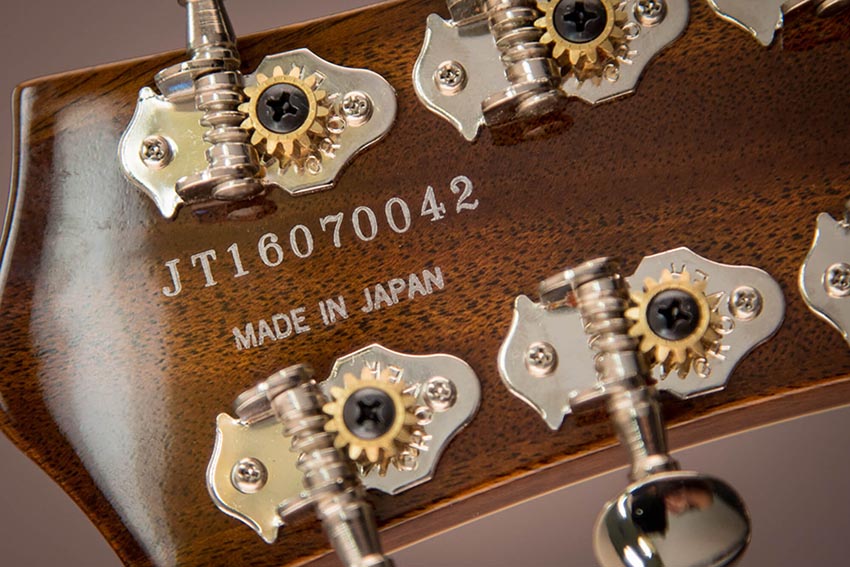DATING GRETSCH GUITARS
1939 TO 1965
From 1939 to 1965, Gretsch serial numbers are sequential, but the manner and placement of the serial numbers on the guitars varies quite a bit.
- In 1939, serial numbers were first penciled in on the inside back of the bodies on the higher end Synchromatics.
- In 1945, Gretsch began impressing serial numbers into the top edges of the headstocks, beginning with some of the lower end guitars.
- In 1949, Gretsch began gluing labels to the inside of guitars. These labels had “Fred Gretsch Mfg. Co” on the label and had lines for the “Model” and “Serial No.”. These labels replaced the method of penciling the serial number on the inside back of the guitar. This form of labeling continued till 1957.
- From 1945 to the early ‘50s, both methods of serial numbering have been seen.
- In 1957 at number 25001, the label was changed to an Orange oval on a Grey and White background. This second iteration of the label had “Fred Gretsch Mfg. Co” with lines for the Model No. and serial No., and it said “Musical Instrument Makers Since 1883” at the bottom. It was used until 1965.
- From the early ‘50s to 1962 the impressed method was rarely used.
- Electrotone and solid body instruments made from 1962 to 1965, once again used the impressed serial number method.
- Some Viking, Falcon and Country Gentlemen guitars made from 1958 to 1965, had the serial number impressed onto the nameplate on the headstocks.
The table identifies Gretsch serial numbers used from 1939 to 1965.

YEAR |
Serial Number Range |
| 1939 to 1946 | 001s to 1,000s |
| 1946 to 1949 | 2,000s |
| 1950 | 4,000s, 5,000s |
| 1951 | 001s to 1,000s |
| 1952 | 5,000s to 6,000s |
| 1953 | 6,000s, 7,000s, 8,000s |
| 1954 | 9,000s, 10,000s, 11,000s, 12,000s |
| 1955 | 13,000s, 14,000s, 15,000s, 16,000s |
| 1956 | 17,000s, 18,000s, 19,000s, 20,000s, 21,000s |
| 1957 | 21,000s, 22,000s, 23,000s, 24,000s, 25,000s, 26,000s |
| 1958 | 26,000s, 27,000s, 28,000s, 29,000s, 30,000s |
| 1959 | 30,000s, 31,000s, 32,000s, 33,000s, 34,000s |
| 1960 | 35,000s, 36,000s, 37,000s, 38,000s, 39,000s |
| 1961 | 40,000s, 41,000s, 42,000s, 43,000s, 44,000s, 45,000s |
| 1962 | 46,000s, 47,000s, 48,000s, 49,000s, 50,000s, 51,000s, 52,000s |
| 1963 | 53,000s, 54,000s, 55,000s, 56,000s, 57,000s, 58,000s, 59,000s, 60,000s, 61,000s, 62,000s, 63,000s |
| 1964 | 63,000s, 64,000s, 65,000s, 66,000s, 67,000s, 68,000s, 69,000s, 70,000s, 71,000s, 72,000s, 73,000s, 74,000s, 75,000s, 76,000s, 77,000s, 78,000s |
| 1965 | 78,000s, 79,000s, 80,000s, 81,000s, 82,000s, 83,000s, 84,000s, 85,000s |
1967 TO THE EARLY 1970s
Toward the end of 1967, Baldwin took over the Gretsch Company. “Made In USA” was added to the serial number stamp and the numbers were date coded in the same way that they had been between ’65 and ’67. These serial numbers were also either 5 or 6 digit numbers, depending on the month of production. The numbers were once again located on the back of the headstock and would have been printed in Gold, Black or White (depending on the color of the guitar).
- The first, and or, first and second number identifies the numerical month of production. For example, 2 would stand for February, 11 would stand for November etc.
- The second or the third number, 7, 8 or 9, (depending on whether the month number is one or 2 digits), identifies the year of production as either 1967, 1968 or 1969 etc.
As an example, serial number 68409 would break down as:
6: June
8: 1968
409: Unit number
As an example, serial number 109837 would break down as:
10: November
9: 1969
837: Unit number
Obviously, with the change of the decade, there is plenty of room for confusion in interpreting the numbers. The numbers for the months, October (10), November (11), and December (12), can also be interpreted as (10) January 1970, (11) January 1971 and (12) January 1972. The only way to be clear, is to have an understanding of the feature sets of the instruments from the era.
In about 1969, Gretsch began to use another version of the Orange and Grey label on F-Hole instruments. This third iteration of the label had “Fred Gretsch Mfg. Co” with lines for the Model No. and serial No., and it said “That Great Gretsch Sound” at the bottom. It was used until 1981. The 5-digit numbers on these labels always begin with 1 or 2 and are sequential, do not follow the “date-coded” convention, and precise dates cannot be determined using the serial numbers.
- Another odd artifact of these 5-digit numbers is that the Electrotone hollow-body guitars from this same time period have numbers from the same sequential series impressed on the upper edge of the headstock. These number are in a much larger font size than the original impressed numbers from ’69 to ’72. There is still some discussion as to why Gretsch may have used this non-conforming numbering scheme during this period on these instruments.
1973 TO 1981
In 1973, the 2nd iteration of the Baldwin era Gretsch label was introduced. These labels were once again a Black and White rectangle, and had “Gretsch Guitars” printed on them, as well as a line for the Baldwin model number and the date coded serial number. These numbers are interpreted in the same way as the earlier date coded numbers, though a hyphen was sometimes placed between the first and second digits better identifying the month/year designation. As an example, 2-365 would be February (2), 1973 (3).
After 2003
In January of 2003 the serial number scheme changed from the system previously used by Gretsch Guitars. The first two digits identify the year of production and the second two digits identify the production month. The remaining numbers identify the sequential yearly factory unit number, and include all instruments, in all models, built in that factory, in that specific year.
For example, serial number JT03074463 would break down as:
- 03: 2003
- 07: July Production
- 4463: 4,463rd guitar built in 2003 (all models combined from that factory)
The last four numbers are sequential for the given year (all models combined) and are broken into two categories as follows:
- 0001 through 0100: Reserved for prototypes, samples, one-offs

